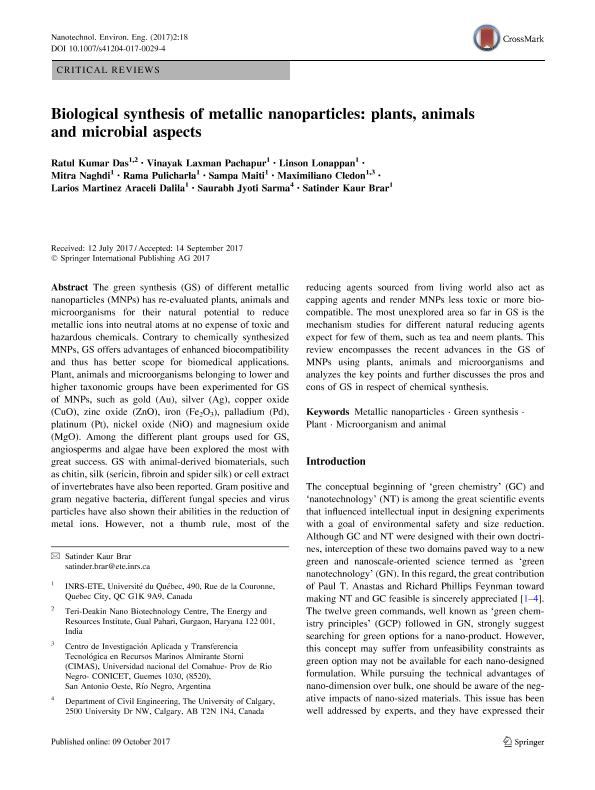Artículo
Biological synthesis of metallic nanoparticles: plants, animals and microbial aspects
Das, Ratul Kumar; Pachapur, Vinayak Laxman; Lonappan, Linson; Naghdi, Mitra; Pulicharla, Rama; Maiti, Sampa; Cledón, Maximiliano ; Dalila, Larios Martinez Araceli; Sarma, Saurabh Jyoti; Brar, Satinder Kaur
; Dalila, Larios Martinez Araceli; Sarma, Saurabh Jyoti; Brar, Satinder Kaur
 ; Dalila, Larios Martinez Araceli; Sarma, Saurabh Jyoti; Brar, Satinder Kaur
; Dalila, Larios Martinez Araceli; Sarma, Saurabh Jyoti; Brar, Satinder Kaur
Fecha de publicación:
12/2017
Editorial:
Springer
Revista:
Nanotechnology for Environmental Engineering
ISSN:
2365-6379
e-ISSN:
2365-6387
Idioma:
Inglés
Tipo de recurso:
Artículo publicado
Clasificación temática:
Resumen
The green synthesis (GS) of different metallic nanoparticles (MNPs) has re-evaluated plants, animals and microorganisms for their natural potential to reduce metallic ions into neutral atoms at no expense of toxic and hazardous chemicals. Contrary to chemically synthesized MNPs, GS offers advantages of enhanced biocompatibility and thus has better scope for biomedical applications. Plant, animals and microorganisms belonging to lower and higher taxonomic groups have been experimented for GS of MNPs, such as gold (Au), silver (Ag), copper oxide (CuO), zinc oxide (ZnO), iron (Fe2O3), palladium (Pd), platinum (Pt), nickel oxide (NiO) and magnesium oxide (MgO). Among the different plant groups used for GS, angiosperms and algae have been explored the most with great success. GS with animal-derived biomaterials, such as chitin, silk (sericin, fibroin and spider silk) or cell extract of invertebrates have also been reported. Gram positive and gram negative bacteria, different fungal species and virus particles have also shown their abilities in the reduction of metal ions. However, not a thumb rule, most of the reducing agents sourced from living world also act as capping agents and render MNPs less toxic or more biocompatible. The most unexplored area so far in GS is the mechanism studies for different natural reducing agents expect for few of them, such as tea and neem plants. This review encompasses the recent advances in the GS of MNPs using plants, animals and microorganisms and analyzes the key points and further discusses the pros and cons of GS in respect of chemical synthesis.
Palabras clave:
GREEN SYNTHESIS
,
METALLIC NANOPARTICLES
,
MICROORGANISM AND ANIMAL
,
PLANT
Archivos asociados
Licencia
Identificadores
Colecciones
Articulos(SEDE CENTRAL)
Articulos de SEDE CENTRAL
Articulos de SEDE CENTRAL
Citación
Das, Ratul Kumar; Pachapur, Vinayak Laxman; Lonappan, Linson; Naghdi, Mitra; Pulicharla, Rama; et al.; Biological synthesis of metallic nanoparticles: plants, animals and microbial aspects; Springer; Nanotechnology for Environmental Engineering; 2; 1; 12-2017; 1-21
Compartir
Altmétricas



